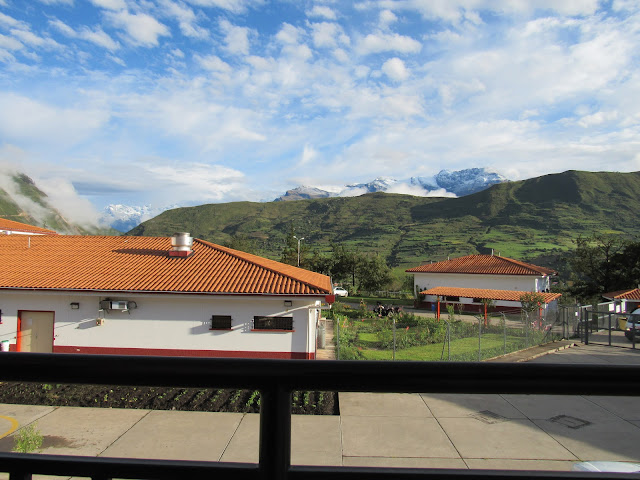On Monday March 1, we were taken to the airport by our great
friend Deborah Martin, and less than 24 hours later, we were at our destination
of Curahuasi, Peru. The wonders of modern travel never cease to
amaze me. Our flights were very smooth and (almost) trouble free,
even though we had to reschedule our flight to Cusco when we reached Lima, for
some unknown reason. But by catching the next flight we arrived only
2 hours later than scheduled.
 |
| At the airport in Atlanta we were given plastic face shields which we had to wear in addition to our facemasks upon arrival in Lima and on our flight to Cusco. |
We were met at the airport by Ricardo,
a capable driver who negotiated the curvy, mountainous, Pan-American Highway to
get to Curahuasi. March is the towards the end of the rainy season
in Peru, so wildflowers and cultivated fields were simply
gorgeous. If you couple that beauty with driving through one of the
deepest gorges in the world (up to 9800 feet deep, twice as deep as the Grand
Canyon), it was almost enough to keep us awake. But fatigue and
altitude of up to 12,000 feet unfortunately conspired against us, and Heleen
slept through one beautiful stretch, and Jon almost dozed off as well.
Arriving in Curahuasi, we were given a room in the
Residencia, which has 10 one room units. They seem luxurious with
hot showers, constant electricity, and internet. Because of
Covid, we were placed in quarantine for the first 5 days. The
hospital served our food in disposable containers, and we rested for the first
day or so. Heleen then began working once again on her studies and Nyandengoh! activities,
while Jon was immersed in learning as much Spanish as possible. The
days seemed a bit similar from day to day, and although we met some of our
neighbors (mostly Peruvian doctors), we had minimal contact with most people in
the hospital.
We soon learned that we would not be able to eat all the
food they would bring us. We found that the Sopa y Segundo served
every day (the lunch meal of soup and a second plate) was enough for 2 meals
for us. So most days we would eat some of the main course (Segundo)
at lunch, and eat leftovers and the soup for supper.
The scenery around the hospital is breathtaking, and
pictures do not really do it justice. There are tantalizing
glimpses, and then more often longer glimpses of the snow-capped Andes
mountains in the background, with their huge snow pack glistening brightly in
the sun, and mountain range upon mountain range piled up on one
another. We probably had our mouths wide open for the first few
times we walked, so it is good they were covered up by our
masks. Two reasons for that—we were puffing so hard to breathe
because of the thin air, and our mouths were open in
awe. Mask-wearing is not optional here, and people are very
compliant with the government rules.
 |
| We love going on early morning walks, when the sky is often clear and the sun shines on the snow-capped mountains. The building with the orange roof below is the hospital. |
 |
| View from our room. |
Difficult things of the transition and altitude adjustment
were overshadowed by the death of Ethan Good, Jon’s father-in-law, on March 3,
1 day after we arrived. Thankfully, we were able to be in contact
with the family the whole time, and also able to view the very meaningful
memorial ceremony online as we grieved together with family at home.
The license for Jon came through on Friday, just in time to
begin work on Monday. The hospital is truly amazing with all modern
equipment that is well-maintained. Sinks work, toilets flush,
electric is no problem, oxygen is made onsite, and everything is very
clean. The grounds are immaculately landscaped with all kinds of
plots of garden plants, fruit trees, and decorative flowers. We just wander
around and wonder at what can be done. So far, Jon’s first week
has been one of learning his way around the hospital, the computer system, and
being totally immersed in Spanish. The first two days, he worked in
the ER, Wednesday with general/family physicians in the outpatient clinic, and
Thursday with the pediatrician. He is supposed to start working on his own next
Monday.
 |
| Ready to work! |
We are so grateful for a good and safe transition and continue
to covet your prayers for a fruitful time here.
 |
| A beautiful flower garden with in the background the hospital chapel. |
 |
This adorable baby alpaca lives on the hospital grounds.
|
 |
| We like to go exploring, and found this wonderful field of wildflowers which is full of all kinds of hummingbirds, jostling and fighting with each other. However, the field is so full of flowers that trying to keep others out is impossible for the feisty birds. |




















































